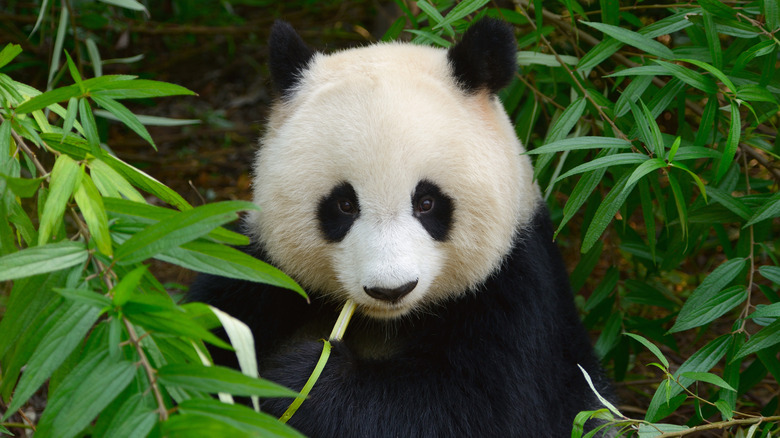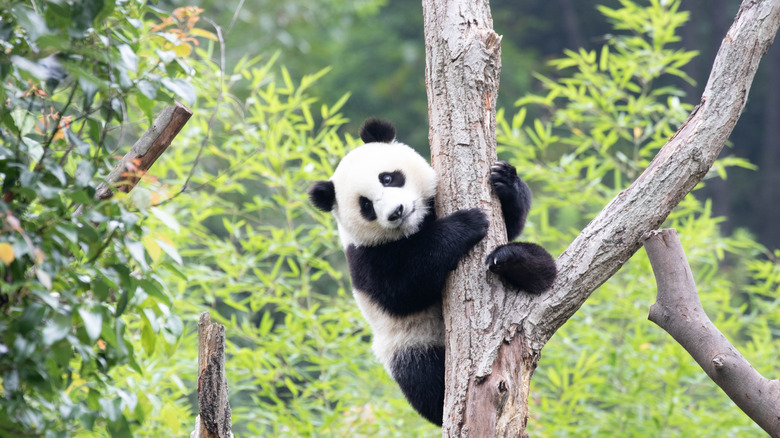One Of China's Best National Parks Is A Massive Sanctuary With Stunning Wildlife & Foliage
There's nothing cuter and cuddlier than the gentle giant panda, and you'll find more at the Giant Panda National Park in China than anywhere else in the world. The huge park is spread over 8,108 square miles, and has united 67 nature reserves which are home to nearly 80% of all of China's wild pandas, as well as more than 8,000 other species of flora and fauna. Located in the Sichuan, Gansu, and Shaanxi provinces, the park, a top tourist destination in China, was established in 2017 as part of a huge conservation effort. It became the first of China's five official national parks in 2021, and has seen the panda population rise to around 1,800, improving their status from endangered to vulnerable on the global list of species at risk of extinction.
The lovable panda is both a symbol of China and a global face of conservation, with its survival story representing decades of work. But he's not the only one roaming the lush bamboo forests, broadleaf and coniferous woodlands, and glacial peaks; there are also clouded leopards, golden snub-nosed monkeys, and takins, with the elusive snow leopard occasionally paying a visit during winter.
While most of the park is off limits to protect the fragile habitat, nearby panda bases are open to visitors, where you can learn about all these species through educational exhibits and conservation programs. When planning a visit, the most practical places to stay are Ya'an, Wenchuan, and Xi'an, which are close to the panda bases. The nearest major airports are in Chengdu, around a two-to-three-hour drive to the park, depending on where you're staying.
Where to see pandas in their natural habitat
Wolong Panda Base is one of the best places to see pandas in the park. Established in 1963, it's been open to the public since 2012. It's home to over 70 pandas, and is the largest breeding center for pandas worldwide. The base is open year-round, but the best time to visit Wolong is from April to November. You can simply enjoy watching the pandas in their natural surroundings, or take part in special programs like panda-keeping and wild trekking volunteer projects. Entry to the base costs $12, while volunteer programs have a mandatory donation fee of around $100-150. All tickets and places must be reserved in advance.
The Ya'an Bifengxia Panda Base, 14 miles from the city of Ya'an in Sichuan, is the second-largest panda base in the park. Established in 2003, it's home to over 40 pandas. The different enclosures provide areas for rescued pandas, pandas born overseas, and, of course, panda cubs. Entry costs $14, and to see the pandas when they're most active, the best time to visit is between 10AM and 2:30PM.
The warm and humid climate within the park provides the ideal environment for the pandas' favorite food — bamboo, which makes up 99% of their diet. This is why protecting bamboo forests is essential to their survival. These normally solitary animals weigh up to 330 pounds and grow up to nearly five feet. They're excellent swimmers and climbers, but unlike other bears, don't hibernate and instead sleep under trees and cliffs, living in elevations between 4,000 and 11,500 feet. Pandas are what's known as an umbrella species, meaning that by protecting them, other animals who share their habitat are protected too.
Other national parks in China worth visiting
Although Giant Panda National Park is one of the best places for spotting rare wildlife up-close, four other beautiful national parks in China are also worth visiting. Before 2021, there were thousands of nature reserves in China, but the government decided to unite them under a recognized national park system based on models from the U.S. and Europe. The five parks were chosen because they're home to China's most critically endangered species and fragile habitats.
The Three-River-Source National Park on the Qinghai-Xizang plateau is known as the "water tower of China". It contains the largest wetland ecosystem in China, and is home to the highest Natural World Heritage site. It provides a sanctuary for protected species such as the snow leopard and Tibetan antelope, drawing worldwide visitors. The Northeast Tiger and Leopard National Park covers an area of 5,444 square miles in the Jilin and Heilongjiang provinces. The dense forests provide a refuge for China's largest population of wild Amur tiger and leopards, two of the world's most endangered big cats.
Hainan Tropical Rainforest National Park is situated on Hainan Island, China's largest stretch of tropical rainforest. If you visit in the drier seasons from November to April, you can enjoy hiking, rafting, and bird-watching. This is also the only place in the world where you'll find the world's rarest primate, the Hainan gibbon, with only around 35 left in the wild. The Wuyi Mountain National Park in the Fujian and Jiangxi provinces is a UNESCO World Heritage site where hundreds of wild animals are protected in its vast mountainous landscape full of rivers, waterfalls, and forests. The park is open year-round, with a range of activities like bamboo rafting, hiking Tianyou Peak, and exploring ancient ruins. The best news is that these five national parks are just the beginning. China plans to eventually expand the national park system with more protected areas.


